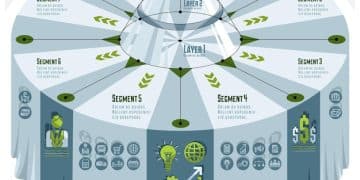US Companies and Carbon Offset Programs: A 2050 Net-Zero Strategy?

US Companies: Are Carbon Offset Programs a Viable Strategy for Achieving Net-Zero Emissions by 2050? This article explores the potential and pitfalls of carbon offsetting as a key component in US companies’ strategies to reach net-zero emissions targets by 2050.
As US Companies: Are Carbon Offset Programs a Viable Strategy for Achieving Net-Zero Emissions by 2050? This question is becoming increasingly critical for businesses committed to sustainability. With growing pressure to reduce their carbon footprint, many US companies are looking at carbon offset programs as a means to mitigate their environmental impact and achieve ambitious net-zero targets. But are these programs truly delivering on their promise?
This article delves into the role of carbon offsets in the broader strategy of US companies striving for net-zero emissions by 2050, examining their potential, limitations, and the crucial factors determining their effectiveness.
Understanding Carbon Offset Programs
Carbon offset programs are designed to compensate for a company’s carbon emissions by investing in projects that reduce or remove greenhouse gases from the atmosphere. These projects can range from reforestation initiatives and renewable energy developments to investments in carbon capture technologies. For US companies, these programs offer a way to address emissions that are difficult to eliminate directly.
How Carbon Offsets Work
The basic principle behind carbon offsets is relatively straightforward: a company calculates its carbon footprint and then purchases credits equivalent to the amount of carbon they wish to offset. These credits fund projects that verifiably reduce emissions elsewhere, effectively neutralizing the company’s impact. However, the devil is in the details. The quality and credibility of offset projects vary significantly.
Types of Carbon Offset Projects
There are numerous types of carbon offset projects available, each with its own set of benefits and challenges. Some common examples include:
- Reforestation: Planting trees to absorb carbon dioxide from the atmosphere.
- Renewable Energy: Investing in wind, solar, or hydroelectric power to displace fossil fuel-based energy production.
- Carbon Capture: Developing technologies to capture carbon emissions directly from industrial sources or the air.
- Methane Capture: Capturing methane from landfills or agricultural operations to prevent its release into the atmosphere.

Ultimately, understanding the nuances of carbon offset programs is critical for US companies looking to make a meaningful impact on their carbon footprint. The choice of projects and the due diligence conducted are important factor in determining the overall effectiveness to the strategy of US Companies: Are Carbon Offset Programs a Viable Strategy for Achieving Net-Zero Emissions by 2050?
The Role of Offsets in Achieving Net-Zero for US Companies
For many US companies, achieving net-zero emissions by 2050 requires a multi-faceted approach. While reducing direct emissions through energy efficiency, renewable energy adoption, and process improvements should be the priority, carbon offsets can play a crucial role in addressing residual emissions that are difficult or impossible to eliminate in the short term.
Offsets as a Complementary Strategy
It’s important to view carbon offsets as a complementary strategy, not a substitute for direct emissions reductions. Companies should prioritize reducing their own emissions as much as possible before relying on offsets to achieve net-zero targets. This ensures that the company is actively working to minimize its environmental impact, rather than simply paying to offset it.
Addressing Scope 3 Emissions
One of the biggest challenges for US companies striving for net-zero is addressing scope 3 emissions, which are indirect emissions that occur throughout the company’s value chain. Carbon offsets can be a valuable tool for mitigating these emissions, particularly when direct reductions are difficult to achieve. For example, a company might purchase offsets to compensate for the emissions associated with employee travel or the production of raw materials.
The Importance of Credible Offsets
The effectiveness of carbon offsets depends heavily on their credibility. To ensure that offsets are truly making a difference, US companies should carefully vet the offset projects they invest in. This includes verifying that the projects are:
- Additional: The emissions reductions would not have occurred without the offset funding.
- Permanent: The emissions reductions are irreversible and not at risk of being reversed in the future.
- Verifiable: The emissions reductions are accurately measured and independently verified.
- Real: The emissions reductions are genuine and not simply a result of accounting tricks.
In summation, carbon offsets can provide a useful tool for US companies as they look at US Companies: Are Carbon Offset Programs a Viable Strategy for Achieving Net-Zero Emissions by 2050?, however, it is merely one tool in the toolbox as companies focus on reducing carbon emissions.
Challenges and Criticisms of Carbon Offset Programs
Despite their potential, carbon offset programs have faced numerous criticisms and challenges. These concerns raise important questions about the effectiveness and integrity of these programs, and highlight the need for greater transparency and rigor in the offset market. One critical aspect to watch is how these programs effect US Companies: Are Carbon Offset Programs a Viable Strategy for Achieving Net-Zero Emissions by 2050?.
Additionality Concerns
One of the most persistent criticisms of carbon offsets is the issue of additionality. To be effective, offset projects must demonstrate that their emissions reductions would not have occurred without the offset funding. In some cases, projects may have already been planned or implemented, regardless of whether they received offset funding. This raises questions about whether the offsets are truly contributing to additional emissions reductions.
Permanence Risks
Another concern is the permanence of emissions reductions. Some offset projects, such as reforestation initiatives, are vulnerable to natural disasters like wildfires or pests, which can release the stored carbon back into the atmosphere. This raises questions about whether these projects can truly deliver long-term emissions reductions.
The issue of leakage
Carbon offsets can also lead to leakage, which occurs when emissions reductions in one area are offset by increased emissions in another area. For example, a project that protects a forest from logging may simply displace logging activity to another forest, resulting in no net reduction in emissions.
Double Counting
Double counting is another potential issue, which occurs when the same emissions reductions are claimed by multiple parties. This can happen if offset projects are not properly tracked and monitored, leading to inflated claims of emissions reductions.

In short, overcoming the challenges and criticisms of carbon offset programs requires a commitment to transparency, rigor, and continuous improvement. US companies must carefully evaluate the offset projects they invest in and work to ensure that these projects are truly delivering on their promise of emissions reductions.
Best Practices for US Companies Using Carbon Offsets
To ensure that carbon offset programs are a credible and effective part of their net-zero strategy, US companies should follow certain best practices. These practices can help companies avoid the pitfalls of low-quality offsets and maximize the impact of their investments.
Prioritize Direct Emissions Reductions
The most important thing is to prioritize direct emissions reductions, mentioned earlier. Companies should actively work to reduce their own emissions as much as possible through energy efficiency, renewable energy adoption, and process improvements.
Set Clear Criteria for Offset Projects
US companies should establish clear criteria for evaluating offset projects. These criteria should include additionality, permanence, verifiability, and real emissions reductions. Companies should also consider the social and environmental impacts of offset projects, ensuring that they do not harm local communities or ecosystems.
Engage with Stakeholders
Companies should engage with stakeholder, including investors, customers, employees, and local communities, to ensure that they are informed about the company’s carbon offset strategy.
Support the Development of High-Quality Offset Standards
Finally, US companies can play a role in supporting the development of high-quality offset standards. By advocating for robust standards and participating in industry initiatives, companies can help to improve the credibility and effectiveness of the carbon offset market.
In closing, adhering to best practices will assist US Companies: Are Carbon Offset Programs a Viable Strategy for Achieving Net-Zero Emissions by 2050?. By taking the best approach, companies can have the best approach and improve the environment.
The Future of Carbon Offsets in the US
The role and shape that carbon offsets will take is constantly evolving, as are US Companies: Are Carbon Offset Programs a Viable Strategy for Achieving Net-Zero Emissions by 2050?. Innovation and improvements will occur over time.
Technological Advances
The development of new technologies, such as direct air capture and carbon mineralization, could create new opportunities for carbon offsetting. These technologies could potentially remove carbon dioxide from the atmosphere more efficiently and at a larger scale than traditional offset projects.
The Role of Carbon Pricing
Carbon pricing mechanisms, such as carbon taxes or cap-and-trade systems, could create a stronger incentive for companies to reduce their emissions. This could lead to increased demand for carbon offsets, as companies seek to comply with carbon pricing regulations.
The Importance of Policy Support
Government policies can play a crucial role in shaping the future of carbon offsets. Policies that support the development of high-quality offset standards, provide incentives for offset projects, and promote transparency in the offset market can help to ensure that carbon offsets are a credible and effective tool for climate action.
Increased Scrutiny
In the future, carbon offset programs are likely to face increased scrutiny. Investors, customers, and regulators will be paying closer attention to the quality and integrity of offset projects, demanding greater transparency and accountability.
Looking ahead from now, it is clear that changes will occur for US Companies: Are Carbon Offset Programs a Viable Strategy for Achieving Net-Zero Emissions by 2050?.
| Key Point | Brief Description |
|---|---|
| 🌱 Carbon Offsets | Compensate for emissions via projects reducing greenhouse gases elsewhere. |
| 🎯 Net-Zero Goal | Achieving balance by 2050 requires cutting emissions & offsetting residual ones. |
| ⚖️ Credibility Matters | Offsets must be additional, permanent, verifiable, and real to be effective. |
| 🔬 Tech & Policy | New technologies, pricing mechanisms, and supportive policies will shape the future. |
Frequently Asked Questions
Carbon offset programs allow companies to invest in projects that reduce or remove greenhouse gases from the atmosphere, compensating for their own emissions. These projects include reforestation and investments in renewable energy.
US companies use carbon offsets to mitigate their environmental impact, particularly for emissions that are difficult to eliminate directly. It helps them achieve sustainability goals and respond to pressure from stakeholders.
Carbon offsets can be a viable part of a broader net-zero strategy, but they should complement, not replace, direct emissions reductions. Credible offsets are essential for meaningful progress.
Criticisms include concerns about additionality, permanence, leakage, and double counting. Ensuring the integrity of offset projects is a significant challenge to overcome for viable projects.
Prioritizing direct emissions reductions, setting clear criteria for offset projects, engaging with stakeholders, and supporting high-quality offset standards are critical for ensuring effectiveness of the strategy that views US Companies: Are Carbon Offset Programs a Viable Strategy for Achieving Net-Zero Emissions by 2050?.
Conclusion
Ultimately, US Companies: Are Carbon Offset Programs a Viable Strategy for Achieving Net-Zero Emissions by 2050? The answer is nuanced. They can be a valuable tool when used strategically and responsibly, complementing direct emissions reduction efforts. However, companies must prioritize credibility, transparency, and continuous improvement to ensure that carbon offsets truly contribute to a sustainable future.
As technology advances and policies evolve, the role of carbon offsets is likely to change. By embracing best practices and supporting the development of high-quality offset standards, US companies can help to shape a future where carbon offsets play a meaningful role in tackling climate change.





